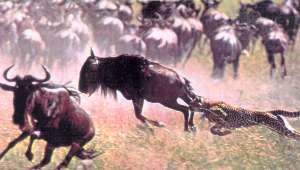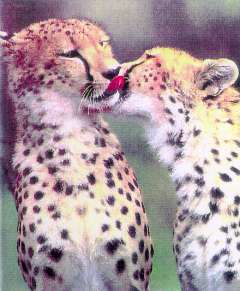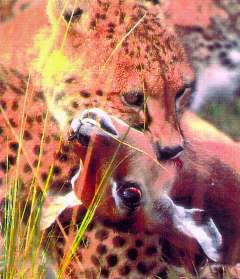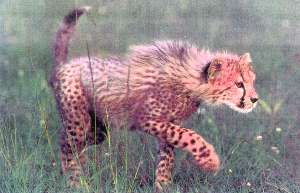|
POINT OF NO RETURN ?? By Elliot Handrus, M.S. A PDF Version (1.4MB) of this article is available HERE |
|||
|
The cheetah has long been admired and revered by man because of its startling burst of speed and its unique beauty. Ancient Assyrians, classical Greeks and Italian noble men have all used cheetahs for various reasons. (Caro 1996.) Even today, a pet cheetah has been a status symbol in Hollywood. However, the cheetah as a species is in danger of becoming extinct for several reasons. We will examine the cheetah and look into some of these reasons. Social Organization The cheetah is unique in many ways among the felids, one of which is its social organization. Lions are of course the only true social cat, where females and young form a pride and males without prides form coalitions. Most other cats lead a solitary existence, coming together to mate and females raising their young. The cheetah has a varied social system. Males will sometimes form bachelor groups and sometimes remain solitary, females will usually be solitary except when they have young, and litter mates will at times remain together after leaving their mother. One of the reasons for this variation is that the cheetah is often pushed away from their kills by lions, hyenas and even jackals. Having more than one animal at a kill can deter these stronger predators from stealing a cheetah kill. Territoriality also varies among cheetahs. Females will generally wander as their favorite food, the Thomson s gazelle, wanders. Some males will follow this same practice, while other males will claim small territories which are prime areas in which many females will gather at certain times of year (Caro 1996.). These territories are often controlled by male coalitions which gang up on solitary males and control the reproductive benefits available in these locations.
Genetics The genetic make-up of cheetahs has been extensively studied over the past 15 years. It has been determined that the cheetah has no genetic heterozygosity and no polymorphic loci (O'Brien et al. 1983.). Most species have 10-60% polymorphic loci within the species and 1-36% of the individuals loci are heterozygous. The genetic make-up of the cheetah is similar to an inbred strain of laboratory mice. The reason for this lack of genetic diversity could be explained by a population bottleneck. In further studies, O'Brien and others investigated the relationship of the east African cheetah (Acinonyx jubatus raineyi) and the south African (Acinonyx jubatus jubatus). Although some of the A. jubatus raineyi showed some heterozygosity, the genetic distance between the subspecies is trivial (0.004) (O'Brien et al. 1987.) This leads to the assumption that there were two population bottlenecks. One was previous to the subdivision into two subspecies, perhaps in the late Pleistocene, followed by a recent bottleneck subsequent to the geographic isolation of the two groups, perhaps within the last 100 years.
The genetic problems leads to the cheetah being in severe danger of disappearing. However, there are arguments to the contrary. Merola states that genetic diversity conforms to taxonomic groups (Selander & Kaufman 1973; Nevo 1978) and the cheetah needs to be compared to other terrestrial carnivores. When this was done, it was shown that 8 species of terrestrial carnivores have less genetic diversity than either of the cheetah subspecies (Simonsen 1982; Allendorf et al. 1979). If this lack of genetic diversity is due to deleterious recessives being selectively removed from the population, then it is possible that there are none of the usual "inbreeding effects." (Wright 1977. Falconer 1981; Lande 1988.). O'Brien (1994) reiterates the danger the cheetah is in. Due to their lack of genetic diversity, reproductive and congenital abnormalities and high cub mortality, the animal is in jeopardy. Habitat destruction is also a severe threat, but the genetic problems are also a reason for serious concern Taxonomy Taxonomy can be determined in many different ways. Biochemically based on blood proteins, morphologically, or using paleontologic evidence, to name a few. Hence, there is rarely an answer that is agreed upon by systematists. It is agreed that the cheetah falls into its own genus Acinonyn within the felids, and it is the only member of this genus. There are two other genera in the family, Panthera and Felis. Panthera includes the lion, tiger, leopard and jaguar, while Felis includes the domestic cats, the small wild cats and the cougar. The cheetah is different based on some unique morphological features. Their claws are only partly retractable as opposed to the fully retractable claws on all other cats. There are also features unique to them because of their need for speed. Based on biochemical data, the closest relative of the cheetah is the puma. An extinct species of the cheetah A. trunzani, was found in the fossil record in the United States, which may explain this relationship (O'Brien et al. 1986). There does exist a color mutant among the cheetah called the king cheetah which has stripes as opposed to spots on its neck and extending down onto parts of the body. This animal had been thought to be a distinct subspecies, but has been found to be merely a color phase, much like the melanistic, or black, color phases of the leopard. Captivity The cheetah was originally brought into captivity in 1871 (Marker 1984). From 1956- 1986, 385 animals were imported, but only 193 were alive at the end of this period (Marker 1989). It has been stated by Nadja Wielebnowski that captive reproductive success has increased over the past 20 years to the point that some facilities have stopped breeding. She further suggests that management factors in zoos are more to blame for the death of cheetah cubs than the animals lack of genetic diversity. The numbers indicate that breeding cheetahs in captivity is not successful, and despite the advances in captive propagation and management techniques, it has yet to be proven that captive propagation is a viable alternative for the survival of the species.
The king cheetah mentioned above provides an interesting question for captive management. Being that it is a unique and beautiful animal, would it be better to breed animals for that pattern, thus decreasing the genetic variability even more, but perhaps increasing the number of visitors to an institution? Would it be better to breed the king cheetah with normal colored animals, perhaps injecting some degree of variability into the population? These are some of the problems faced by captive institutions. This beautiful, unique animal is at a crisis point. Due to habitat destruction and poor genetics its survival both in nature and captivity is in question. Man has some control over the habitat destruction, and must stop destroying the planet or the cheetah and other unique organisms will be gone. Literature Cited Allendorf, F.W F.B. Christiansen, T. Dobson, W.F. Eanes, and 0. Frydenberg, 1979 Electrophoretic variation in large mammals. Hereditas 91:19-22. Caro, Tim. 1996 An Elegant Enigma. Wildlife Conservation 99 (3):44-47. Falconer, D.S. 19'81. Introduction to quantitative genetics. Longman, New York Lande, R. 1988. Genetics and demography in biological conservation. Science 241:1455-1459. Larson, R.E. 1980 Current Therapy in Theriogenology, ed. Morrow, D.A. Saunders, Philadelphia. 646-654. Marker, L. 1984. North American Regional Cheetah Studbook. Winston Wildlife Safari Publ. Marker, L., S.J. O'Brien. 1989. Captive Breeding of the Cheetah (Acinonyx jubatus) in North American Zoos (1871-1986). Zoo Biology 8:3-16. Merola, M. 1994. A reassessment of homozygosity and the case for inbreeding depression in the cheetah, Acinonyx jubatus. implications for conservation. Conservation Biology 8 (4): 961-971. Nevo, E:. 1978. Genetic variation in natural populations: Patterns and theory. Theoretical Population Biology 13:121-177. O'Brien, S.J., D. E. Wildt, D. Goldman, D. R. Merril, and M. Bush. 1983. The cheetah is depauperate in genetic variation. Science 221:459-462 O'Brien, S.J., D. E. Wildt, and M. Bush. 1986 The cheetah in genetic peril. Scientific American 254:84-92. O'Brien, S.J., D. E. Wildt, M. Bush, T.M. Caro, C. Fitzgibbon, I. Aggundey, and R.E. Leakey. 1987 East African cheetahs: Evidence for two population bottlenecks? Proceedings of the National Academy of Sciences USA 84:508-511. O'Brien, S. J. 199'4. The cheetahs conservation controversy. Conservation Biology 8 (4): 1153-1155. Salisbury, G. W., R. G. Hart, and J. R. Lodge. 1977. American Journal of Obstetrics and Gynecology 128:342-350. Selander, D. K. and D. W. Kaufman. 1973. Genetic variabilities and strategies of adaptation in animals. Proceedings of the National Academy of Sciences USA 70:1875-1877. Simonsen, V. 1982. Electrophoretic variation in large mammals. Hereditas 96:299-305. Wielebnowski, N . 1996. Reassessing the relationship between juvenile mortality and genetic monomorphism in captive cheetahs. Zoo Biology 15 (4): 353-369. Wright, S. l 977 Evolution and the genetics of populations. A treatise in four volumes. Vol. 3. Experimental results and evolutionary deductions. University of Chicago Press, Chicago, Illinois. *The photographs are from Wildlife Conservation 99(3):44-47, by Art Wolfe, Joe McDonald and Tom Brakefield. |
|||
|
|
|||
|
For translation information and instructions, please CLICK HERE. http://www.colyerinstitute.org
This web site is best viewed with a browser setting of 800 x 600 or greater. If you use a smaller screen size and would like to view the content of this site using an alternate interface, please click here.
|
|||

 When
the female cheetah leaves her cubs to hunt, their den is at times
discovered by lions. The lions will then proceed to kill the cubs, hence
only about 10% of cheetah cubs survive in the wild. It does appear that
cheetah population numbers vary inversely with lion populations. ln
Kenya, numbers of wild cheetah has remained relatively constant over the
past 30 years (Caro 1996.).
When
the female cheetah leaves her cubs to hunt, their den is at times
discovered by lions. The lions will then proceed to kill the cubs, hence
only about 10% of cheetah cubs survive in the wild. It does appear that
cheetah population numbers vary inversely with lion populations. ln
Kenya, numbers of wild cheetah has remained relatively constant over the
past 30 years (Caro 1996.). Another
problem is the seminal traits of cheetah. Both wild and captive animals
were electroejaculated. The number of motile spermatozoa was
approximately one-sixth of the amount in the domestic cat (O'Brien et
al. 1987.). This is comparable to what would be considered infertility
in other mammalian species (Salisbury et al. 1977; Larson 1980.).
Another
problem is the seminal traits of cheetah. Both wild and captive animals
were electroejaculated. The number of motile spermatozoa was
approximately one-sixth of the amount in the domestic cat (O'Brien et
al. 1987.). This is comparable to what would be considered infertility
in other mammalian species (Salisbury et al. 1977; Larson 1980.).